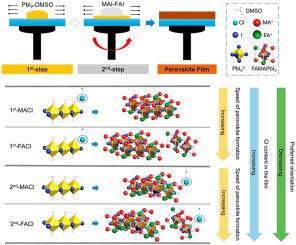Materials Today Energy ( IF 9.3 ) Pub Date : 2020-10-01 , DOI: 10.1016/j.mtener.2020.100551 J. Bing , D.S. Lee , Y. Cho , J. Zheng , Y. Li , S. Tang , Meng Zhang , S. Huang , A.W.Y. Ho-Baillie

|
In this work, for the first time, we identify the effect of adding chlorine (Cl) in the dynamic sequential (no stoppage between the sequential steps and the precursor for the second-step is dispensed while the substrate is in motion) solution processing of formamidinium methylammonium lead iodide FA0.3MA0.7PbI3 perovskite solar cells by comparing (i) the roles of two different Cl sources (MACl and FACl) and (ii) the time at which the Cl sources were added: (a) into PbI2-DMSO in the first deposition step or (b) into MAI-FAI in the second deposition step. It is found that Cl in general (regardless of the type of source and at which step it is added) improves the perovskite film with better coverage, better crystallinity, and higher photoluminescence response and longer carrier lifetime due to reduced trap densities. Characterizations for investigating film formation mechanisms reveal that the amount of Cl remaining in the final film is most crucial in determining the film quality. This in turn is controlled by when Cl is added. When Cl is added in the second step, the higher Cl content which is highly diffusive initiates the Dimethyl sulfoxide (DMSO) complex formation and perovskite formation too rapidly producing films with excess PbI2, which are more disorder and have lower crystallinity. FACl exacerbates this while MACl reduces the detrimental effect by slowing down perovskite formation. Therefore, for dynamic sequential processing, it is recommended that MACl is used as the preferred source over FACl and Cl should be added in the 1st step of the process allowing sufficient Cl to leave the film in the 2nd step of the sequential process. The resulting film has better film quality producing a champion device with a 2.8% absolute efficiency increase over the best device fabricated without Cl additives. This work has provided great insights into the film formation mechanism by sequential processing with additive engineering.
中文翻译:

了解动态顺序过程中的氯添加剂如何影响用于太阳能电池的FA 0.3 MA 0.7 PbI 3钙钛矿薄膜的生长
在这项工作中,我们首次确定了在动态顺序中加入氯气(Cl)的效果(在连续步骤和第二步的前体之间没有停止,而基板处于运动状态)的溶液处理通过比较(i)两种不同的Cl源(MACl和FACl)的作用和(ii)添加Cl源的时间:(a)到PbI 2中的甲酰胺基甲基铵碘化铅FA 0.3 MA 0.7 PbI 3钙钛矿型太阳能电池在第一沉积步骤中将-DMSO或在第二沉积步骤中将(b)转化为MAI-FAI。已经发现,由于降低的陷阱密度,总的来说,Cl(不管来源的类型和添加步骤的不同)都改善了钙钛矿膜,具有更好的覆盖率,更好的结晶度,更高的光致发光响应和更长的载流子寿命。用于调查膜形成机理的表征表明,最终膜中残留的Cl量对于确定膜质量至关重要。这又由添加Cl的时间控制。在第二步中添加Cl时,较高的Cl含量具有很高的扩散性,因此会很快形成二甲基亚砜(DMSO)络合物和钙钛矿的形成过程,从而产生具有过量PbI 2的薄膜,它们更加无序且结晶度较低。FAC1加剧了这一点,而MAC1通过减缓钙钛矿的形成降低了有害作用。因此,对于动态顺序处理,推荐使用MAC1作为优于FAC1的优选来源,并且应该在该过程的第一步骤中添加Cl,以允许足够的Cl在该顺序过程的第二步骤中离开膜。所得的薄膜具有更好的薄膜质量,与不使用Cl添加剂制造的最佳器件相比,绝对值效率提高了2.8%的冠军设备。这项工作通过添加工程的顺序处理为成膜机理提供了深刻的见识。


























 京公网安备 11010802027423号
京公网安备 11010802027423号